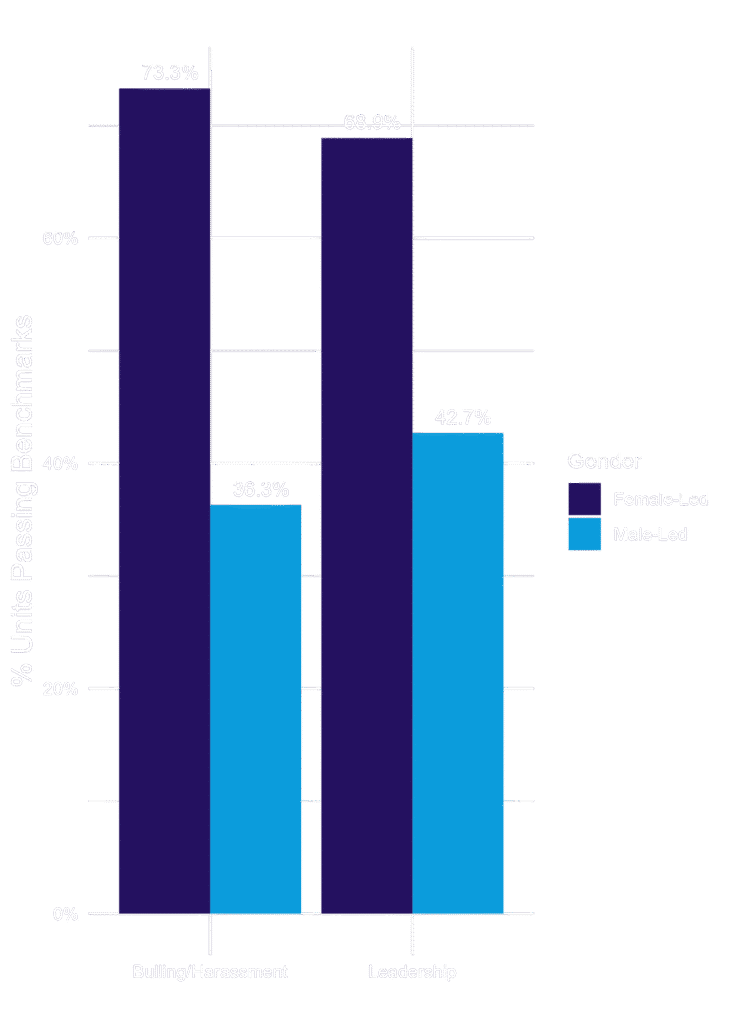Background
The techniques, types and abilities of leaders is a large and growing field, with some research showing women have more desirable leadership qualities than men, and female-led organisations are more successful (Zenger and Folkman, 2019).
University of Edinburgh staff opinions are gathered bi-annually through a Staff Engagement Survey. This assesses staff opinions on a range of factors, including leadership and bulling and harassment. Following the 2023 survey, research was undertaken to explore gender differences in the leadership and bullying & harassment satisfaction rates, for female vs male led departments.
Methods
Among the staff surveyed, there were 47 Schools/directorates (units) with high enough response rates to have publishable data under Higher Education Statistical Agency rounding and suppression guidelines. Of these 47, 15 were led by women, 32 by men.
The overall University of Edinburgh satisfaction score was the total percentage of respondents who selected “agree” or “strongly agree”. This was used as a benchmark, with a School/directorate passing the benchmark if the scored higher than the University as a whole. The proportion of both female-led and male-led units passing benchmarks was recorded and two proportion Z-tests were performed to see if the difference in these proportions was significant.
The null for the one-tailed tests hypothesised that the proportion of female-led and male-led units passing the benchmarks would be equal, with the alternative being that the proportion of female-led units passing was higher. A significance level of 0.05 was used during testing.
Findings
Leadership
There were three metrics under this theme. Note these have been coded for brevity, with the original statements being full sentences with the ability to respond on a Likert scale.
- Leaders are visible
- Leaders have clear vision
- Confidence in leadership
The benchmarks for these items were 25%, 26% and 23% respectively. There were 15 female-led units and 32 male-led across the 3 metrics. Therefore there were a total of 45 benchmarks to pass for women, 96 for men.
Female-led units passed 31 out of 45 benchmarks, a passing rate of 68.9%. Male-led units passed 41/96, 42.7%. The Z-test demonstrated there was strong statistical evidence to suggest female-led units were more likely to pass benchmarks for leadership.
Bullying and Harassment
There were two types of question under this theme, one being a binary Yes/No answer, the other on a Likert scale. The first type had two metrics:
- Experienced bullying and harassment
- Experienced discrimination
The benchmark for these items were 91% responding No and 92% No, respectively. The second type had three metrics:
- Bullying dealt with
- Discrimination dealt with
- Inappropriate behaviour dealt with
Benchmarks were 45%, 51% and 45%, respectively. Thus there were 75 benchmarks to pass for women, 160 for men. Female-led units passed 55/75 benchmarks, a passing rate of 73.3%. Male-led units passed 58/160, a rate of 36.3%.
The Z-test again showed this was a statistically significant difference, with there being strong statistical evidence supporting the alternative hypothesis, that female-led units were more likely to pass benchmarks for the bullying/harassment theme.

Impact
This research was presented to the University Equality, Diversity and Inclusion committee at the University of Edinburgh, to encourage conversation about shifting recruitment trends and practices. The University Lead for EDI then shared the data at the University Executive Away Day as food-for-thought.
References
Zenger, J. and Folkman, J. (2019). Women score higher than men in most leadership skills, VJ Holcomb. Available at: http://vjholcomb.com/wp-content/uploads/2020/03/Research_-Women-Score-Higher-Than-Men-in-Most-Leadership-Skills.pdf (Accessed: 26 August 2025).


